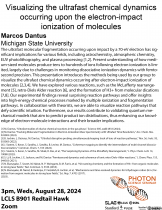SLAC, Redtail Hawk Conference Room 108A
Zoom
Join from PC, Mac, Linux, iOS or Android: https://stanford.zoom.us/j/95047492194?pwd=bVJcT0LhbeT13nO2ooIkiZfa4wOIPH.1
Password: 937988
Or iPhone one-tap (US Toll): +18333021536,,95047492194# or +16507249799,,95047492194#
Or Telephone:
Dial: +1 650 724 9799 (US, Canada, Caribbean Toll) or +1 833 302 1536 (US, Canada, Caribbean Toll Free)
Meeting ID: 950 4749 2194
Password: 937988
International numbers available: https://stanford.zoom.us/u/asXNSQ2xr
Meeting ID: 950 4749 2194
Password: 937988
SIP:
Password: 937988
Speaker: Marcos Dantus, Michigan State University
Program Description
The ultrafast molecular fragmentation occurring upon impact by a 70-eV electron has significant implications for various fields, including astrochemistry, atmospheric chemistry, EUV photolithography, and plasma processing [1,2]. Present understanding of how medium-sized molecules produce tens to hundreds of ions following electron ionization is limited, largely due to challenges in monitoring dissociative ionization dynamics with femtosecond precision. This presentation introduces the methods being used by our group to visualize the ultrafast chemical dynamics occurring after electron-impact ionization of molecules [2,3,4]. We have explored various reactions, such as the McLafferty rearrangement [5], retro-Diels Alder reaction [6], and the formation of H3+ from molecular dications [7,8]. Our experimental findings reveal surprising reaction pathways and offer insights into high-energy chemical processes marked by multiple ionization and fragmentation pathways. In collaboration with theorists, we are able to visualize reaction pathways that defy scientific intuition. Furthermore, our results contribute to validating quantum mechanical models that aim to predict product ion distributions, thus enhancing our knowledge of electron-molecule interactions and their broader implications.
References:
[1] M. Dantus, “Ultrafast studies of elusive chemical reactions in the gas phase,” Science 385, eadk1833 (2024).
[2] M. Dantus “Tracking Molecular Fragmentation in Electron-Ionization Mass Spectrometry with Ultrafast Time Resolution,” Acc. Chem. Res. 033003 (2024).
[3] B. Jochim, L. DeJesus, M. Dantus, “Ultrafast disruptive probing: simultaneously keeping track of tens of reaction pathways,” Rev. Sci. Instr. 93, 033003 (2022).
[4] J. Stamm, S. Kwon, S. Sandhu, J. Sandhu, B. Levine, M. Dantus, “Coherence mapping to identify the intermediates of multi-channel dissociative ionization,” Commun. Chem. 7, 103 (2024).
[5] J. Stamm, S. Kwon, S. Sandhu, M. Shaik, R. Das, et al, “The Surprising Dynamics of the McLafferty Rearrangement,” J. Phys. Chem. Lett. 14, 10088 (2023).
[6] S. Li, B. Jochim, J. E. Jackson, and M. Dantus “Femtosecond dynamics and coherence of ionic retro-Diels–Alder reactions,” J. Chem. Phys. 155, 044303 (2021).
[7] N. Ekanayake, T. Severt, M. Nairat, N. P. Weingartz, B. M. Farris, et al, “H2 roaming chemistry and the formation of H3+ from organic molecules in strong laser fields,” Nat. Commun. 9, 5186 (2018).
[8] N. Ekanayake, M. Nairat, B. Kaderiya, P. Feizollah, B. Jochim, et al, “Mechanisms and time-resolved dynamics for trihydrogen cation (H3+) formation from organic molecules in strong laser fields,” Sci. Rep. 7, 4703 (2017).





